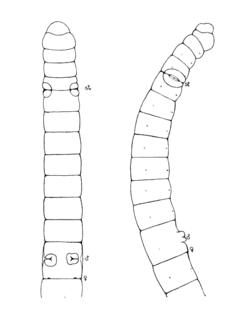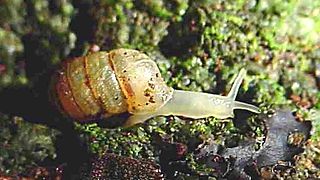
The Cyclopteridae are a family of marine fishes, commonly known as lumpsuckers or lumpfish, in the order Scorpaeniformes. They are found in the cold waters of the Arctic, North Atlantic, and North Pacific oceans. The greatest number of species are found in the North Pacific. The family name Cyclopteridae derives from the Greek words κύκλος (kyklos), meaning "circle", and πτέρυξ (pteryx), meaning "wing" or "fin", in reference to the circle-shaped pectoral fins of most of the fish in this family.

Ice worms are enchytraeid annelids of the genus Mesenchytraeus. The majority of the species in the genus are abundant in gravel beds or the banks of riverine habitats, but the best-known members of the genus are found in glacial ice. They include the only annelid worms known to spend their entire lives in glacial ice, and some of the few metazoans to complete their entire life cycle at conditions below 0 °C (32 °F).
The Rhodocyclaceae are a family of gram-negative bacteria. They are given their own order in the beta subgroup of Proteobacteria, and include many genera previously assigned to the family Pseudomonadaceae.
Thiobacillus is a genus of Gram-negative Betaproteobacteria. Thiobacillus thioparus is the type species of the genus, and the type strain thereof is the StarkeyT strain, isolated by Robert Starkey in the 1930s from a field at Rutgers University in the United States of America. While over 30 "species" have been named in this genus since it was defined by Martinus Beijerinck in 1904,, most names were never validly or effectively published. The remainder were either reclassified into Paracoccus, Starkeya ; Sulfuriferula, Annwoodia, Thiomonas ; Halothiobacillus, Guyparkeria, or Thermithiobacillus or Acidithiobacillus. The very loosely defined "species" Thiobacillus trautweinii was where sulfur oxidising heterotrophs and chemolithoheterotrophs were assigned in the 1910-1960s era, most of which were probably Pseudomonas species. Many species named in this genus were never deposited in service collections and have been lost.
The Deferribacteraceae are a family of gram-negative bacteria which make energy by anaerobic respiration.
The Thermotogota are a phylum of the domain Bacteria. The phylum Thermotogota is composed of Gram-negative staining, anaerobic, and mostly thermophilic and hyperthermophilic bacteria.

The Polyporaceae are a family of poroid fungi belonging to the Basidiomycota. The flesh of their fruit bodies varies from soft to very tough. Most members of this family have their hymenium in vertical pores on the underside of the caps, but some of them have gills or gill-like structures. Many species are brackets, but others have a definite stipe – for example, Polyporus badius.

Streptaxidae is a family of carnivorous air-breathing land snails, terrestrial pulmonate gastropod mollusks in the clade Stylommatophora. Six Streptaxidae subfamilies are accepted in the 2005 taxonomy of the Gastropoda by Bouchet & Rocroi.
The Chloroflexota are a phylum of bacteria containing isolates with a diversity of phenotypes, including members that are aerobic thermophiles, which use oxygen and grow well in high temperatures; anoxygenic phototrophs, which use light for photosynthesis ; and anaerobic halorespirers, which uses halogenated organics as electron acceptors.

Chaetolopha is a genus of moths in the family Geometridae. Most species are endemic to Australia. A number of species previously assigned to this genus, were reassigned to the new genus Parachaetolopha in 2002.

The Haemosporida are an order of intraerythrocytic parasitic alveolates.
Torodora is a genus of moths in the family Lecithoceridae. The genus was erected by Edward Meyrick in 1894.

Pneumatoraptor is a genus of small, paravian dinosaur that lived in Hungary. It is known from a single complete left shoulder girdle (scapulocoracoid) found in the Csehbánya Formation of the Iharkút locality in the Bakony Mountains of western Hungary. This formation dates to the late Cretaceous period about 85 million years ago.
Nitrospirota is a phylum of bacteria. It includes multiple genera, such as Nitrospira, the largest. The first member of this phylum, Nitrospira marina, was discovered in 1985. The second member, Nitrospira moscoviensis, was discovered in 1995.

The Haemoproteidae are a family of parasitic alveolates in the phylum Apicomplexa.

Opecoelidae is a family of trematodes. It is the largest digenean family with over 90 genera and nearly 900 species, almost solely found in marine and freshwater teleost fishes. It was considered by Bray et al. to belong in the superfamily Opecoeloidea Ozaki, 1925 or the Brachycladioidea Odhner, 1905.

The Blissidae are a family in the Hemiptera, comprising nearly 50 genera and 400 species. The group has often been treated as a subfamily of the Lygaeidae but was resurrected as a full family by Thomas Henry (1997).
The Diplocystidae are a family of parasitic alveolates in the phylum Apicomplexa.
Ooperipatus is a genus of Australian velvet worms in the Peripatopsidae family. All species in this genus have 15 pairs of legs.
Tatria duodecacantha is a species of tapeworm in the family Amabiliidae. It infects the pied-billed grebe.








